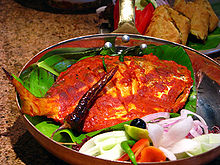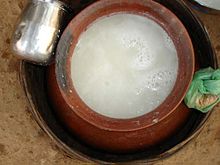Inidan Cuisine
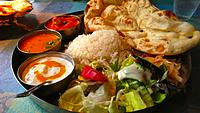
A La Cart!!! Food in the Streets of India
The Indian culinary experience has been diversified and modified to a large extent owing to the waves of migration, climate and the tastes of the local population. As a result, Indian food in general, and street food in particular, draws inspiration from multiple sources but always reflects local tastes. Hugely popular, very affordable, and wonderfully delicious, Indian street food has come to represent a remarkable innovation and adaptation to the changing times. From Mumbai to Delhi to Lucknow and Kolkata- the film travels through the sheer size, variety and nuances within the Indian food palette seen through the eyes of four celebrities, who take the viewer on an intimate culinary exploration of the street food they love in their cities.
 Indian Cuisine encompasses a wide variety of regional cuisines native to India. Given the range of diversity in soil type, climate and occupations, these cuisines vary significantly from each other and use locally available spices, herbs, meat, vegetables, and fruits. Indian food is also heavily influenced by religious and cultural choices. The development of these cuisines have been shaped by Hindu and Jain beliefs, and in particular by vegetarianism, which is a growing dietary trend in Indian society. There has also been Persian influence on North Indian cuisine from the years of Mughal and Delhi Sultanate rule. Indian cuisine has been and is still evolving, as a result of the nation’s cultural interactions with other societies. Historical incidents such as foreign invasions, trade relations and colonialism have also played a role in introducing certain foods to the country. For instance, potato, a staple of North Indian diet was brought to India by the Portuguese, who also introduced chillies and breadfruit. Indian cuisine has also shaped the history of international relations; the spice trade between India and Europe is often cited by historians as the primary catalyst for Europe’s Age of Discovery. Spices were bought from India and traded around Europe and Asia. It has also influenced other cuisines across the world, especially those from Southeast Asia, the British Isles and the Caribbean.
Indian Cuisine encompasses a wide variety of regional cuisines native to India. Given the range of diversity in soil type, climate and occupations, these cuisines vary significantly from each other and use locally available spices, herbs, meat, vegetables, and fruits. Indian food is also heavily influenced by religious and cultural choices. The development of these cuisines have been shaped by Hindu and Jain beliefs, and in particular by vegetarianism, which is a growing dietary trend in Indian society. There has also been Persian influence on North Indian cuisine from the years of Mughal and Delhi Sultanate rule. Indian cuisine has been and is still evolving, as a result of the nation’s cultural interactions with other societies. Historical incidents such as foreign invasions, trade relations and colonialism have also played a role in introducing certain foods to the country. For instance, potato, a staple of North Indian diet was brought to India by the Portuguese, who also introduced chillies and breadfruit. Indian cuisine has also shaped the history of international relations; the spice trade between India and Europe is often cited by historians as the primary catalyst for Europe’s Age of Discovery. Spices were bought from India and traded around Europe and Asia. It has also influenced other cuisines across the world, especially those from Southeast Asia, the British Isles and the Caribbean.
History
Indian cuisine reflects a 5000-year history of various groups and cultures interacting with the subcontinent, leading to diversity of flavours and regional cuisines found in modern-day India. Later British and Portuguese influence added to the already diverse Indian Cuisine.
Antiquity
A normal diet in early India consisted of fruit, vegetables, grain, eggs, dairy products, honey, and sometimes meat. Over time, segments of the population embraced vegetarianism. The advent of Buddhism affected this shift, as well as an equitable climate permitting a variety of fruit, vegetables, and grains to be grown throughout the year. A food classification system that categorised any item as saatvic, raajsic or taamsic developed in Ayurveda. The Bhagavad Gita prescribes certain dietary practices (Chapter 17, Verses 8–10). During this period, consumption of beef became taboo, due to cattle being considered sacred in Hinduism. Many Indians continue to follow this belief, making the use of beef in Indian cuisine somewhat rare. Beef is generally not eaten by upper caste Hindus in India. An exception is Kerala where no such taboo exists.
Middle Ages
During the Middle Ages, several North Indian dynasties were predominant, including the Gupta dynasty. Travellers to India during this time introduced new cooking methods and products to the region, including tea and spices. Northern India was later invaded by Central Asian cultures, which led to the emergence of Mughlai cuisine, a mix of Indian and Central Asian cuisine. Hallmarks include seasonings such as saffron, Trade with the ancient Sumerian, Assyrian and later Arab cultures also helped import several of those culinary techniques.
Ingredients 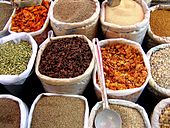 Spices at a grocery shop in India
Spices at a grocery shop in India
Staple foods of Indian cuisine include pearl millet (bajra), rice, whole-wheat flour (atta), and a variety of lentils, especially masoor (most often red lentils), toor (pigeon pea), urad (black gram), and moong (mung bean). Lentils may be used whole, dehusked—for example, dhuli moong ordhuli urad—or split. Split lentils, or dal, are used extensively. Some pulses, such as channa(chickpea), Rajma or kidney beans, lobiya are very common, especially in the northern regions.Channa and mung, are also processed into flour (besan). Many Indian dishes are cooked in vegetable oil, but peanut oil is popular in northern and western India, mustard oil in eastern India, and coconut oil along the western coast, especially in Kerala. Gingelly (sesame) oil is common in the south wince it imparts a fragrant nutty aroma. In recent decades, sunflower and soybean oils have become popular across India. Hydrogenated vegetable oil, known as Vanaspati ghee, is another popular cooking medium. Butter-based ghee, or desi ghee, is used frequently, though less than in the past.
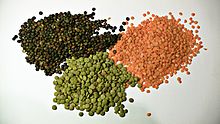 Lentils are a staple ingredient in Indian cuisine
Lentils are a staple ingredient in Indian cuisine
The most important and frequently used spices and flavourings in Indian cuisine are whole or powdered chilli pepper (mirch) (introduced by the Portuguese in the 16th century), black mustard seed (sarso), cardamom (elaichi), cumin (jeera), turmeric (haldi), asafoetida (hing), ginger (adrak),
coriander (dhania), and garlic (lehsun). One popular spice mix is garam masala, a powder that typically includes five or more dried spices, especially cardamom, cinnamon (dalchini), and clove. Each culinary region has a distinctive garam masala blend—individual chefs may also have their own. Goda masalais a comparable, though sweet, spice mix popular in Maharashtra. Some leaves commonly used for flavouring include bay (tejpat), coriander, fenugreek, and mintleaves. The use of curry leaves and roots for flavouring is typical of Gujarati and South Indian cuisine. Sweet dishes are often seasoned with cardamom, saffron, nutmeg, and rose petal essences.
Regional cuisines – List of Indian dishes
Cuisine differs across India’s diverse regions as a result of variation in local culture, geographical location (proximity to sea, desert, or mountains) and economics. It also varies seasonally, depending on which fruits and vegetables are ripe.
Andaman and Nicobar Islands
Seafood plays a major role in the cuisine of the Andaman and Nicobar Islands. Since the indigenous Andamanese traditionally had very little contact with the outside world, raw fish and fruits have long been a staple diet for them. Immigration from other regions of India, however, has resulted in variations in the cuisine. Pesarattu, a popular Andhra dish, served with kobbari pachadi(chutney made using coconut)
Andhra Pradesh, Telugu cuisine and Hyderabadi cuisine
Cuisine of Andhra Pradesh is a blend of Telugu cuisine along with Hyderabadi cuisine (also known as Nizami cuisine). The food is rich in spices, for which it is popular among south Indian cuisine. Rice is the staple food of Andhra people. Starch is consumed with a variety of curries and lentil soups or broths. Vegetarian and non-vegetarian foods are both popular. Seafood is common in the coastal region of the state. Hyderabadi cuisine includes popular delicacies such as Biryani, Hyderabadi Haleem, Baghara baingan and kheema. Variouspickles are part of local cuisine, popular among those are avakaya (a pickle made from raw mango) and gongura (a pickle made from red sorrel leaves). Yogurt is a common addition to meals, as a way of tempering spiciness. Breakfast items like dosa, vada are influenced by spices native to Andhra Pradesh.
Arunachal Pradesh – Cuisine of Arunachal Pradesh
The staple food of Arunachal Pradesh is rice, along with fish, meat and leaf vegetables. Many varieties of rice are used. Lettuce is the most common vegetable, usually prepared by boiling with ginger, coriander and green chillies. Boiled rice cakes wrapped in leaves are a popular snack. Thukpa is a kind of noodle soup common among the Monpa tribe of the region. Native tribes of Arunachal are meat eaters and use fish, eggs, chicken, pork and mutton to make their dishes. Apong or rice beer made from fermented rice or millet is a popular beverage in Arunachal Pradesh and is consumed as a refreshing drink.
Assam – Assamese cuisine 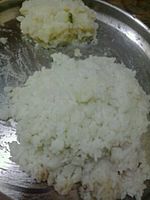 An Assamese food containing boiled rice mixed with salt and mustard oil and boil potato mixed with onion, green chilli, salt and mustard oil.
An Assamese food containing boiled rice mixed with salt and mustard oil and boil potato mixed with onion, green chilli, salt and mustard oil.
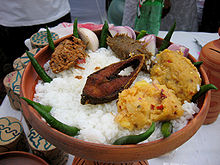 Panta Ilish—a traditional platter of Panta bhat with fried ilish slice, supplemented with dried fish (shutki), pickles (achar), dal, green chillies, and onion—is a popular dish for the Pohela Boishakh festival.
Panta Ilish—a traditional platter of Panta bhat with fried ilish slice, supplemented with dried fish (shutki), pickles (achar), dal, green chillies, and onion—is a popular dish for the Pohela Boishakh festival.
Assamese cuisine is a mixture of different indigenous styles, with considerable regional variation and some external influences. Although it is known for its limited use of spices, Assamese cuisine has strong flavours from its use of endemic herbs, fruits, and vegetables served fresh, dried or fermented. Fish is widely eaten. The region’s cuisine involves simple cooking processes. Bhuna, the gentle frying of spices before the addition of the main ingredients, generally common in Indian cooking, is absent in the cuisine of Assam. A traditional meal in Assam begins with a khar, a class of dishes named after the main ingredient and ends with a tenga, a sour dish. The food is usually served in bell metalutensils. Paan, the practice of chewing betel nut, generally concludes a meal.
Bihar – Bihari cuisine – Bhojpuri cuisine and Mithila (India)
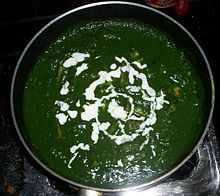 Palak paneer, a dish made from spinach and paneer (cottage cheese)
Palak paneer, a dish made from spinach and paneer (cottage cheese)
Bihari cuisine is wholesome and simple. It is mainly influenced by their neighbours. Biharies are fond of meat. Litti chokha, a baked salted wheat flour cake filled with sattu ( baked chickpea flour ) and some special spices, is famous among the middle-class families. Meat saalan is a famous dish made of lamb curry in garam masala and cubed potatoes. Dalpuri is another popular dish in Bihar. It is salted wheatflour bread, filled with boiled, crushed and fried gram pulses. Malpua is a popular sweet dish of Bihar, prepared by a mixture of maida, milk, banana, grated coconut, cashew nut, raisin, sugar, water and green cardamom. Another famous sweet dish of Bihar is Balushahiwhich is prepared by a specially treated combination of maida and sugar along with ghee. During the festival of Chhath, thekua, a sweet dish made of ghee, jaggery, whole-meal flour, flavoured with aniseed, is made.
Chandigarh
Chandigarh is the Union Territory and the Capital of both Punjab and Haryana. The local cuisine are common to cuisine of Punjab and Haryana. Chattisgarh Chattisgarh cuisine uses many foods not found in the rest of India, although the staple food is rice, like in much of the country. Many Chattisgarhi people drink liquor brewed from the Mahuwa flower. The tribal people of the Bastar region of Chhattisgarh eat whatever is available, including food which would not be eaten by people of other states and regions, such as red ant chutney.Flying ants, mushrooms, squirrels, bamboo pickle, bamboo vegetable, suran ki sabji and but fish a large part of Chhatisgarhi cuisine.
Dadra and Nagar Haveli
The population of Dadra and Nagar Haveli are tribal in nature and the local cuisine shows resemblances with cuisine of Gujarat. Ubadiyu is a local delicacy made up of vegetables and beans with herbs. The common food includes rice, roti, vegetables and river fishes and crab. People also enjoy buttermilk and chutney made up of different fruits and herbs.
Daman and Diu
Daman and Diu is a union territory of India which, like Goa, was a former colonial possession of Portugal. Consequently, both native Gujarati food and traditional Portuguese food are common. Being a coastal region, the communities are mainly dependent on sea food. Normally, Rotli and tea are taken for breakfast, Rotla and saag for lunch and chokha along with saag and curry are taken for dinner. Some of the dishes prepared on festive occasions include, puri, lapsee, potaya, dudh-plag, dhakanu. While alcohol is prohibited in the neighbouring state of Gujarat, drinking is common in Daman and Diu. All popular brands of alcohol are readily available. Goa – Goan cuisine – Saraswat cuisine and Malvani cuisine
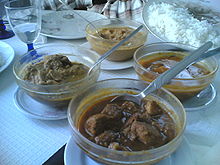 Pork Vindaloo (pictured). Vindaloo is a popular curry dish in Goa.
Pork Vindaloo (pictured). Vindaloo is a popular curry dish in Goa.
The area has a tropical climate and the spices and flavours here are intense. Use of kokum is a distinct feature of the region’s cuisine. Goan cuisine is mostly seafood based; the staple foods are rice and fish. Kingfish (Vison or Visvan) is the most common delicacy, and others include pomfret, shark, tuna, and mackerel; these are often served with coconut milk. Shellfish, including crabs, prawns, tiger prawns, lobster, squid and mussels are commonly eaten. The cuisine of Goa is influenced by its Hindu origins, four hundred years of Portuguese colonialism, and modern techniques. Bread is eaten with most of the meals. Frequent tourism in the area gives Goan food an international aspect. Brahmins belonging to Pancha Dravida are strict vegetarians.
- Goan Recipes by BonGong.com – Gujarat – Gujarati cuisine
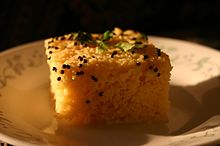 Khaman is a popular Gujarati snack.
Khaman is a popular Gujarati snack.
Gujarati cuisine is primarily vegetarian. The typical Gujarati thali consists of roti (rotli in Gujarati), daal or kadhi, rice, sabzi/shaak and papad. The sabzi is a dish of different combinations of vegetables and spices which may be stir fried, spicy or sweet. Gujarati cuisine can vary widely in flavour and heat based on personal and regional tastes. North Gujarat, Kathiawad, Kachchh, and South Gujarat are the four major regions of Gujarati cuisine. Many Gujarati dishes are simultaneously sweet, salty, and spicy. In mango season keri no ras (fresh mango pulp), is often an integral part of the meal. Spices also vary seasonally. For example, garam masala is used less in summer. Regular fasting, with diets limited to milk, dried fruit, and nuts, is a common practice.
Haryana
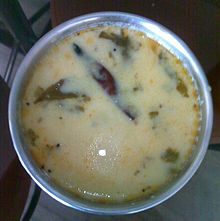 Kadhi, a spicy north Indian dish
Kadhi, a spicy north Indian dish
Cattle being common in Haryana, dairy products are a common component of its cuisine. Specific dishes include kadhi, pakora, besan masala roti, bajra aloo roti, churma, kheer, bathua raita, methi gajar, singri ki sabzi, and tamatar chutney. Lassi and sharbat and nimbu pani are three popular non-alcoholic beverages in Haryana. Liquor stores are common there, which cater to the traffic of many truck drivers.
Himachal Pradesh – Culture of Himachal Pradesh Cuisine
The daily diet of Himachal people is similar to that of the rest of North India, including lentils, broth, rice, vegetables, and bread, although non-vegetarian cuisine is preferred. Some of the specialities of Himachal include sidu, patande and til chutney.
Jammu and Kashmir – Cuisine of Kashmir
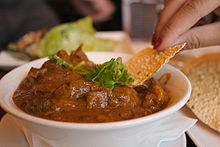 Rogan Josh is a popular Kashmiri dish.
Rogan Josh is a popular Kashmiri dish.
Kashmiri cuisine has evolved over hundreds of years. Its first major influence was the food of the Kashmiri Hindus and Buddhists. The cuisine was later influenced by the cultures which arrived with the invasion of Kashmir by Timur from the area of modern Uzbekistan. Subsequently influences have included the cuisines of Central Asia, Persia, and the North Indian plains. The most notable ingredient in Kashmiri cuisine is mutton, of which there are over 30 varieties. Wazwan is a multicourse meal in the Kashmiri Muslim tradition, of which, the preparation is considered an art. Kashmiri Pandit food is elaborate, and an important part of the Pandits’ ethnic identity. Kashmiri Pandit cuisine usually uses yogurt, oils, and spices such as turmeric, red chilli powder, cumin, ginger, and fennel, though they do not use onion and garlic.
Jharkhand – Traditional cuisine of Jharkhand
Traditional Jharkhand dishes are not available at restaurants, as they have not been commercialised. Prepared exclusively in tribal regions, this cuisine uses oil and spices infrequently, except for pickle production and special occasions. Baiganee Chop, a snack made of brinjal slices or egg plant, is popular in Jharkhand. Thekua is a sweet dish made of sugar, wheat, flour and chopped coconuts. Hadia, which is made out of paddy rice is a refreshing drink. A wide variety of recipes are prepared with different types of rice in Jharkhand which include recipes like Dhuska, Pittha and different kinds of Rotis prepared with rice.
Karnataka – Cuisine of Karnataka
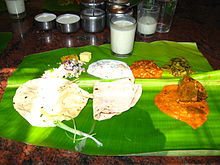 Karnataka food served on a plantain leaf
Karnataka food served on a plantain leaf
Varieties in the cuisine of Karnataka reflect influences from the three neighbouring South Indian states, as well as the states of Maharashtra and Goa to its North. Typical dishes include bisi bele bath, jolada rotti, chapati, ragi rotti, akki rotti, saaru, huli, vangibath,khara bath, kesari bath, benne dose, ragi mudde, and uppittu. The Kodagu district is famous for spicy pork curries (pig curry) while coastal Karnataka specialises in seafood. Although the ingredients differ regionally, a typical Kannadiga Oota (Kannadiga meal) is served on a banana leaf. The coastal districts of Dakshina Kannada and Udupi have slightly varying cuisines, which make extensive use of coconut in curries and frequently include seafood.
Kerala – Cuisine of Kerala
Kerala cuisine blends indigenous dishes with foreign ones adapted to local tastes. Coconuts grow in abundance in Kerala, so grated coconut and coconut milk are commonly used for thickening and flavouring. Kerala’s long coastline and numerous rivers have led to a strong fishing industry in the region, making seafood a common part of the meal. Rice is grown in abundance; along with tapioca. It is the main starch ingredient used in Kerala’s food. Having been a major production area of spices for thousands of years, the region makes frequent use of black pepper, cardamom, clove, ginger, and cinnamon. Most of Kerala’s Hindus, except its Brahmin community, eat fish, beef and non-vegetarian foods; common among these are chicken, beef, pork catering to Kerala’s large minorities of Muslims and Christians. In most Kerala households, a typical meal consists of rice, fish, and vegetables. Kerala also has a variety of breakfast dishes like idli, dosa, appam, idiyappam, puttu, and pathiri.
Lakshadweep
The culinary influence of Kerala is quite evident in the cuisines of Lakshadweep, since the island lies in close proximity to Kerala. Coconut and sea fish serve as the foundations of most of the meals. The people of Lakshadweep drink large amounts of coconut water, which is the most abundant aerated drink on the island.
Madhya Pradesh
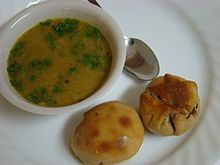 Daal Bafla, a popular dish in Madhya Pradesh, Rajasthan and Gujarat
Daal Bafla, a popular dish in Madhya Pradesh, Rajasthan and Gujarat
The cuisine in Madhya Pradesh varies regionally. Wheat and meat are common in the North and West of the state, while the wetter South and East are dominated by rice and fish. Milk is a common ingredient in Gwalior and Indore. The street food of Indore is renowned, with shops that have been active for generations. Bhopal is known for meat and fish dishes such as rogan josh, korma, keema, biryani, pilaf and kebabs. There is street named “Chatori Gali” in old Bhopal where one can find traditional Muslim non-veg fare like Paya Soup, Bun Kabab, Nalli-Nihari as some of the specialties. Dal bafla is a common meal in the region and can be easily found in Indore and other nearby regions, consisting of a steamed and grilled wheat cake dunked in rich ghee which is eaten with daal and ladoos. The culinary speciality of the Malwa and specially Indore region of central Madhya Pradesh is poha (flattened rice); usually eaten at breakfast with jalebi. Beverages in the region include lassi, beer, and rum and sugarcane juice. A local liquor is distilled from the flowers of the mahua tree and date palm toddy is also popular. In tribal regions, a popular drink is the sap of the sulfi tree, which may be alcoholic if it has gone through fermentation.
Maharashtra – Maharashtrian cuisine
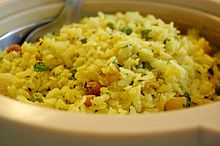 Poha, a popular breakfast dish in Madhya Pradesh
Poha, a popular breakfast dish in Madhya Pradesh
Maharashtrian cuisine includes a range of dishes from mild to very spicy tastes. Bajri, wheat, rice, jowar, vegetables, lentils, and fruit form important components of the Maharashtrian diet. Popular dishes include puran poli, ukdiche modak, batata wada,masala bhat and wada pav. Shrikhand, a sweet dish made of strained yogurt, is a main dessert of Maharashtrian cuisine. The cuisine of Maharashtra can be divided into two major sections—the coastal and the interior. The Konkan, on the coast of the Arabian Sea has its own type of cuisine, a homogeneous combination of Malvani, Goud Saraswat Brahmin, and Goan cuisines. In the interior of Maharashtra, the Vidarbha andMarathwada areas have their own distinct cuisines. Apart from Konkan, the state’s cuisine uses ground nuts, jaggery, wheat, jowar, andbajra extensively. A typical meal consists of rice and poli (roti) both along with varan andaamtee—lentils and spiced vegetables. Like other coastal states, there is an enormous variety of vegetables eaten, and fish and coconuts are common. Peanuts and cashews are often served with vegetables. Grated coconuts are used to flavour many types of dishes, but coconut oil is not widely used; peanut oil is preferred. Kokum, most commonly served chilled, in an appetiser-digestive called sol kadhi, is prevalent. During summer, Maharashtrians consume panha, a drink made from raw mango (to see more go to website above).

